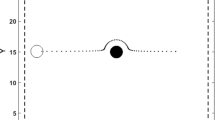Abstract
Modeling the movement of a rigid particle in viscous fluid is a problem physicists and smathematicians have tried to solve since the beginning of this century. A general model for an ellipsoidal particle was first published by Jeffery in the twenties. We exploit the fact that Jeffery was concerned with formulae which can be used to compute numerically the velocity field in the neighborhood of the particle during his derivation of equations of motion of the particle. This is our principal contribution to the subject. After a thorough check of Jeffery's formulae, we coded software for modeling the flow around a rigid particle based on these equations. Examples of its applications are given in conclusion. A practical example is concerned with the simulation of sigmoidal inclusion trails in porphyroblast.
Similar content being viewed by others
References
A. Einstein: Eine neue Bestimmung der Moleküldimensionen. Ann. Physik 19 (1906), 289–306, errata 84 (1911), 591–592.
N. C. Gay: The motion of rigid particles embedded in a viscous fluid during pure shear deformation of the fluid. Tectonophysics 5 (1968), 81–88.
S. K. Ghosh, H. Ramberg: Reorientation of inclusions by combination of pure shear and simple shear. Tectonophysics 34 (1976), 1–70.
/. S. Gradshtein, I. M. Ryzhik: Table of Integrals, Series, and Products. 5th ed. Boston, Academic Press 1994.
G. B. Jeffery; The motion of ellipsoidal particles immersed in a viscous fluid. Proc. Roy. Soc. London Ser. A 102 (1922), 161–179.
J. Jezek: Software for modeling the motion of rigid triaxial particles in viscous flow. Computers and Geosciences 20 (1994), 409–424.
J. Ježek, S. Saic, K. Segeth, K. Schulmann: Three-dimensional hydrodynamical modelling of viscous flow around a rotating ellipsoidal inclusion. Computers and Geosciences 25 (1999), 547–558.
J. Ježek, K. Schulmann, K. Segeth: Fabric evolution of rigid inclusions during mixed coaxial and simple shear flows. Tectonophysics 257 (1996), 203–221.
T. Masuda, S. Mochizuki: Development of snowball structure: numerical simulation of inclusion trails during synkinematic porphyroblast growth in metamorphic rocks.. Tectonophysics 170 (1989), 141–150.
W. H. Press et al.: Numerical Recipes. The Art of Scientific Computing. Cambridge, Cambridge University Press 1986.
L. J. Reed, E. Tryggvason: Preferred orientations of rigid particles in a viscous matrix deformed by pure shear and simple shear. Tectonophysics 24 (1974), 85–98.
S. Wolfram: Mathematica. A System for Doing Mathematics by Computer. Reading, MA, Addison-Wesley 1993.
Author information
Authors and Affiliations
Rights and permissions
About this article
Cite this article
Ježek, J., Saic, S. & Segeth, K. Numerical modeling of the movement of a rigid particle in viscous fluid. Applications of Mathematics 44, 469–479 (1999). https://doi.org/10.1023/A:1022276905724
Issue Date:
DOI: https://doi.org/10.1023/A:1022276905724




